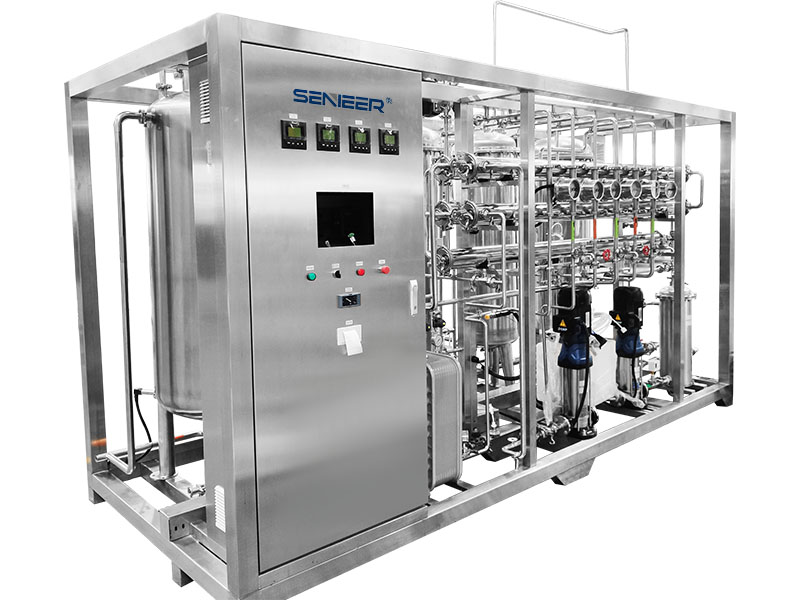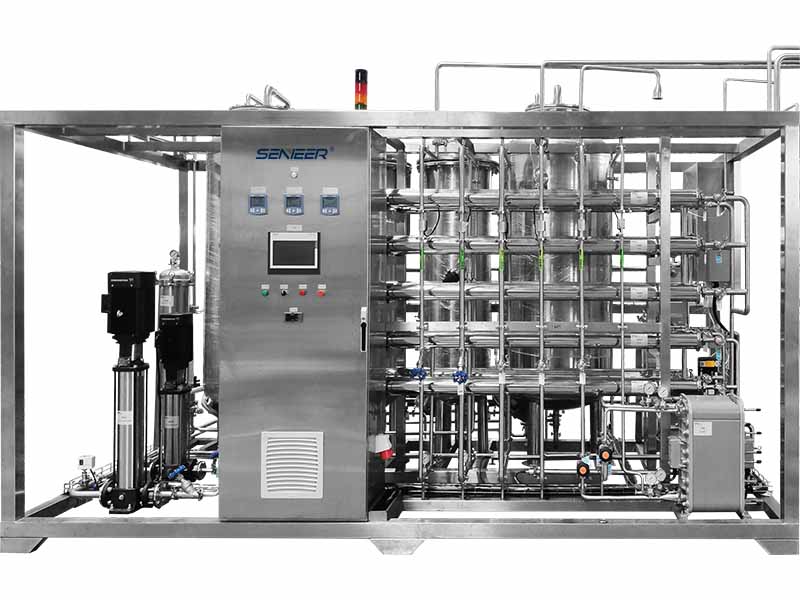Objective: To establish the microbial database of the pharmaceutical water system of a high-risk injection production enterprise, and provide guidance for the effective control and traceability investigation of the microorganisms in the pharmaceutical water system of the enterprise.
Methods: For four consecutive quarters, the purified water system and water for injection system of a large-capacity injection production enterprise were monitored and collected microorganisms, and the polluting microorganisms were identified based on 16S rRNA and ITS rDNA sequence comparison methods, and analyzed in combination with the microbial species and source information , Establish the microbial bacterial bank of the enterprise’s pharmaceutical water system.

Results: A total of 1499 strains of bacteria and 20 strains of fungi were isolated and identified, and the microorganisms in the water for injection system and the purified water system accounted for 9.0% and 91.0%, respectively. Sphingomonas and Methylobacterium were the most in the purified water system, accounting for 28.9% and 25.2% of all isolates, respectively. There were more Staphylococcus and Micrococcus in the WFI system, accounting for 24.9% and 18.2% of all collected bacteria, respectively. The microorganisms polluted in the purified water system were mainly Gram-negative bacteria, accounting for 67.0% of the total number of polluted microorganisms. The microorganisms contaminated in the WFI system were mainly Gram-positive bacteria, accounting for 60.3% of the total number of contaminated microorganisms. The more common fungi in pharmaceutical water systems are Aspergillus versicolor and Penicillium chrysogenum. In addition, the analysis found that the number of microorganisms in the purified water system accounted for a large proportion in the second and third quarters, accounting for 67.8% of the total number of microorganisms in the year, while the number of microorganisms in the first and fourth quarters decreased; the number of microorganisms in the water for injection system It is more in the second quarter, and the other three seasons are almost the same.
Conclusion: The establishment of the microbial bacterial bank of the pharmaceutical water system can guide the operation, maintenance and disinfection of the pharmaceutical water system, and also provide a traceability investigation basis for microbial contamination incidents in high-risk pharmaceutical manufacturers.
Pharmaceutical water is the most widely used raw material in the process of drug production, especially the water for injection used by injection manufacturers, which will directly enter the human body through injection, directly affecting the safety of patients. The preparation, storage and distribution system of pharmaceutical water is the key system of pharmaceutical production. The Good Manufacturing Practice (GMP) stipulates that pharmaceutical production enterprises should monitor the microbial load and other indicators of pharmaceutical water according to the monitoring plan, and pass the annual quality review. The job analyzes whether the pharmaceutical water is continuously in a stable and controlled state. With the implementation of the new version of GMP, pharmaceutical companies have begun to pay attention to the risk control of pharmaceutical water systems, especially the control of microorganisms in water. Because microorganisms in the water system can float or adhere to the inner walls of pipes and storage tanks, etc., and can reproduce in large numbers to form biofilms, they can continuously release microorganisms to form a persistent pollution source, and biofilms are also the main reason for the formation of endotoxins.
Microbiological detection is an important indicator to evaluate whether pharmaceutical water is qualified, and the detection and control of microbial indicators is a necessary and complicated task. Especially for high-risk sterile drug manufacturers, through the systematic and scientific collection and analysis of microorganisms in the pharmaceutical water system, and the use of appropriate identification methods to investigate the microorganisms in the normal state of pharmaceutical water, it can help manufacturers better understand the daily pharmaceuticals. Evaluation of the operation and disinfection of the water system can also further guide the sterilization, disinfection and cleaning of the pharmaceutical water system. The established microbial bacterial library of the pharmaceutical water system can also lay a data foundation for the pharmaceutical production environment bacterial library collected based on the risk level of microorganisms and drug characteristics analysis, and help trace the source of contaminated microorganisms in pharmaceuticals.
Part 1 Materials
1.1 Instrument
ME2002E electronic balance (Mettler-Toledo, Switzerland); MLS-3781-PC high-pressure steam sterilizer (Sanyo, Japan); biological safety cabinet (Likang Biomedical Technology Holdings Co., Ltd.); SF450 sterilization box, IF450 The constant temperature incubator and ICP55 low temperature incubator are from Memmert, Germany; the HTY-2000B bacteria collection instrument and FC502 single-use bacteria collection incubator are from Hangzhou Tailin Biotechnology Equipment Co., Ltd.; ABI3730-XL sequencer (ABI company in the United States) .
1.2 Medium
Tryptone soy agar medium (TSA, batch number: 1064583) and R2A agar medium (lot number: 1061327) were provided by Guangdong Huankai Microbiology Technology Co., Ltd.; the applicability inspection of the above medium complied with the regulations of the Chinese Pharmacopoeia 2015 edition.
Part 2 Method And Results
2.1 Collection Of Microorganisms In The Pharmaceutical Water System
In this study, the total water supply point, return water point, use point, water supply point of injection water system, return water point and use point of each workshop purified water of a large-capacity injection sterile drug production enterprise were sampled for four consecutive quarters. According to the Chinese Pharmacopoeia 2015 version of purified water standards for microbial limit inspection. The total water supply point and return water point of each distribution system of purified water shall be sampled and inspected daily, and each use point shall be sampled and inspected monthly; the water supply point of the injection water system and the return water point of each workshop shall be sampled and inspected daily, and each use point shall be sampled and inspected monthly.
2.2 Isolation And Preservation Of Microorganisms In Pharmaceutical Water Systems
A total of 1 499 strains of bacteria and 20 strains of fungi were collected. The collected microorganisms were resuscitated, isolated and purified. The resuscitated medium was TSA and R2A agar medium, and magnetic beads were used to store them in a refrigerator at −70 °C. Some strains that could not be recovered were identified directly by a single pure colony.
2.3 Bacterial 16S rDNA Full-Length Sequencing And Fungal ITS rDNA Sequencing Identification
The 1 499 strains of bacteria and 20 strains of fungi collected from the pharmaceutical water system were identified by sequencing the bacterial 16S rDNA and fungal ITS rDNA respectively. The databases compared in this study included NCBI-Fungi and NCBI-Bacteria (homology>98.65% determined to be the same microorganism).
2.4 Microbial Contamination Analysis Of Pharmaceutical Water System
A total of 1 519 microbial strains in the pharmaceutical water system were collected through 4 consecutive quarters, including 1 499 bacterial strains and 20 fungal strains. Among them, 132 bacterial strains came from the water for injection system, 1 367 bacterial strains came from the purified water system; 4 fungal strains came from the water for injection system, and 16 fungal strains came from the purified water system. The microorganisms from the water for injection system accounted for 9.0%, and the microorganisms from the purified water system accounted for 91.0%. Bacteria accounted for 98.7% of the entire pharmaceutical water system, and fungi accounted for 1.3%.
2.5 Changes In Microbial Contamination With Seasons
The number of microorganisms in the purified water system accounted for a large proportion in the second and third quarters, accounting for 67.8% of the total number of microorganisms in the year, while the number of microorganisms in the first and fourth quarters decreased; Many, the remaining three seasons have similar numbers. This may be related to seasonal factors such as temperature and humidity. It has also been reported that the proportion of Gram-negative bacteria detected in the pipelines of pharmaceutical water systems increases during the high water season, suggesting that during these periods it is necessary to pay attention to whether the cleaning and disinfection of water system pipelines are in place.
2.6 Establishment And Analysis Of Microbial Bacterial Bank In Pharmaceutical Water System
Sphingomonas and Methylobacterium were the most in the purified water system, accounting for 28.9% and 25.2% of all isolates, respectively; followed by Micrococcus, Brevibacterium and Comamonas, accounting for 12.8% of all collected bacteria , 8.0% and 7.8%. There were more Staphylococcus and Micrococcus in the water for injection system, accounting for 24.9% and 18.2% of all collected bacteria, respectively; followed by Bacillus and Methylobacterium, accounting for 10.3% and 8.8% of all isolated bacteria, respectively. This study preliminarily established a pharmaceutical water microbial library by sorting out and analyzing the sequencing and identification results of pharmaceutical water microorganisms collected in four quarters.
Part 3 Discussion
From the comparative analysis of various aspects of the established pharmaceutical water microbial library, it can be seen that the vast majority of microorganisms in the pharmaceutical water system are Gram-negative bacteria, accounting for 64.2%. Among them, 55 strains of Pseudomonas were collected. Pseudomonas microorganisms are easy to form biofilms, which can easily cause the microbial load in the water system to exceed the standard, which will affect the safety of products and patients. Therefore, strict control in the water system is required. Use heat disinfection (usually 80 ℃) to kill such heat-sensitive microorganisms. Spore-type microorganisms account for 3%, and currently the international community also lists spore-type microorganisms as unacceptable microorganisms in products. Therefore, if such microorganisms that are difficult to disinfect appear in pharmaceutical water systems, attention should also be paid attention to. The more common fungi in pharmaceutical water systems are Aspergillus versicolor and Penicillium chrysogenum. From the FDA’s Bad Bud Book Pathogen Reference Manual, it can be known that Aspergillus and Penicillium belong to the category of unacceptable microorganisms. FDA has also recalled products because of the presence of these two types of microorganisms in products. For these two types of mold, it is necessary to develop effective disinfection and sterilization methods to prevent these microorganisms from forming biofilms and causing greater harm.

The microorganisms polluted by the water for injection system collected in this study are mainly Gram-positive bacteria. It is possible that Gram-positive bacteria have thicker cell walls and better heat resistance, and are more resistant to the temperature of the water for injection system (70~ 80°C). The microorganisms polluted by the purified water system are mainly Gram-negative bacteria. Therefore, targeted microbial control measures can be taken according to the different types of microorganisms in the purified water system and the water for injection system. Gram-positive bacteria in the water for injection system are mainly considered to come from the purified water system in a small amount, and more likely to be pollution caused by the external environment. Therefore, enterprises need to focus on the impact of the external environment on the water for injection system to ensure the cleanliness of the water for injection system Clean (including various sampling points and use points), and at the same time, conduct a systematic inspection of the water for injection system, focusing on whether the maintenance is in place and whether there are locations that may communicate with the outside.
In this study, microorganisms in pharmaceutical water were collected through 4 quarters of continuous sampling, and a microbial library of pharmaceutical water systems in high-risk drug manufacturers was initially established. However, the establishment of environmental microbial libraries is a continuous and dynamic process, so it needs to be continuously improved in daily monitoring. . The establishment of the microbial bacterial library of the pharmaceutical water system can help manufacturers to better evaluate the daily water system operation and disinfection effects, and establish different disinfection programs according to the bacterial populations. Provide the basis for traceability investigation.










